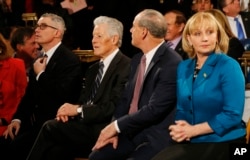If you were alive and in America in 1968, you might remember the phrase “You’ve Come A Long Way, Baby.”
It was an advertising slogan for a brand of cigarettes, known as Virginia Slims.
This collection of television commercials shows how the company framed the product as "tailored for the feminine hand," and, more to the point, as a symbol of women's empowerment.
The ad campaign successfully captured the zeitgeist of the United States at that time with an image of a confident, tall, slender, pants suit-wearing woman on the go, mirroring the country’s mainstream awareness of the women’s rights movement, led by feminist Gloria Steinem, Bella Abzug, Betty Friedan and many other activists.
Some 40 years after the launch of the ad, much has changed: advertising cigarettes is banned on radio and television, and a woman, Hillary Clinton, has clinched the nomination for president for the first time in American history.
“When women reach critical mass, somewhere between 20 to 30 percent of any institution, they change fundamentally the way that institution functions,” said Jay Newton-Small, author of Broad Influence: How Women Are Changing the Way America Works and a correspondent for Time magazine.
"And certainly women are reaching that point in Congress, as well as in the [Obama] administration and [U.S.] courts.”
Just look at the numbers, said Newton-Small. American women have reached that critical mass in all three branches of the federal government.
“Thirty percent of the government in terms of high-level civil service and political appointees are women, 35 percent of the federal bench are women, including 40 percent of state judges."
The notion that women are affecting political change is being tested by Clinton—whose resume as an elected female is unmatched, having served as a former first lady, two-term senator and secretary of state—as she heads towards the November vote, most likely against presumptive Republican nominee Donald Trump.
How much power?
Women currently comprise 53 percent of eligible American voters. Furthermore, Newton-Small pointed out, women on average actually pull the lever 10 percent more often than eligible male voters. Their votes have been decisive in every presidential election since President Ronald Reagan's two-terms in the 1980s.
There is no doubt that women voters in America are a force to be dealt with.
But that doesn’t answer a key question: how much power do women in elected office actually have to make things happen? And what factors contribute to a woman's decision to run for office?
A few years ago, two scholars spotted an intriguing trend in New Jersey, one that resulted in landmark research.
Susan Carroll, Senior Scholar at the Center for American Women and Politics at Rutgers University and a professor of gender studies, and her colleague Kelly Dittmar, noticed a big jump in the number of women in New Jersey's state legislature between 2004 and 2011: 25 women—16 Democrats and 9 Republicans—entered the legislature for the first time, and five women already in the state assembly moved to the upper chamber.
Their 2012 study, "Preparedness Meets Opportunity: Women's Increased Representation in the New Jersey Legislature," teased out the whys behind the spike: Opportunity, corruption, scandals, deaths and resignations opened 12 seats; women, they found, were seen as a more ethical alternative.
Perhaps more importantly, Carroll and Dittmar found those female office-holders were groomed at the grassroots level and encouraged to run.
And since then?
“We’ve maintained,” Carroll said. “We haven’t necessarily continued to move upward. As you get more women there, it gets harder to maintain the numbers because you have to have a lot of success just to keep the numbers where they are.”
In other words, Carroll said it’s a lot easier to go from one to three women in elected office than from 30 to 90.
Tipping the balance
The growing and—now sustained—presence of women in the halls of political power has already made possible what was once what drove Steinem and thousands of women into the streets: family medical leave, a law protecting women from domestic violence and a dramatic increase in funding for breast cancer research. In the last year, it was female senators, Newton-Small said, who forced huge reforms in the handling of sexual assault in the U.S. military.
The examples of women pushing hard to get big issues on the table, and winning, are compelling. That said, there remain notable gaps in the American political landscape:
Women currently serve as governor in only six of the 50 states.
“We still have a long way to go before we reach parity in terms of office-holding,” said Carroll, a seasoned political scientist. “It’s still a male-dominated enterprise, there’s no question about it.”
Hillary
All of this leaves American women waiting to see: Can Hillary Clinton punch through the thickest and most important glass ceiling in American politics to become the nation's first woman president?
“Being a woman and having power is still somewhat oxymoronic in our society,” said Jo Freeman, a long-time feminist scholar, activist and author of the 2008 book We Will Be Heard: Women's Struggles for Political Power in the United States.
"It’s better than it was 40 years ago. But a woman with power still makes people uncomfortable," she said. "And the presidency is the most powerful position in the country, and maybe even the most powerful position in the world.”












